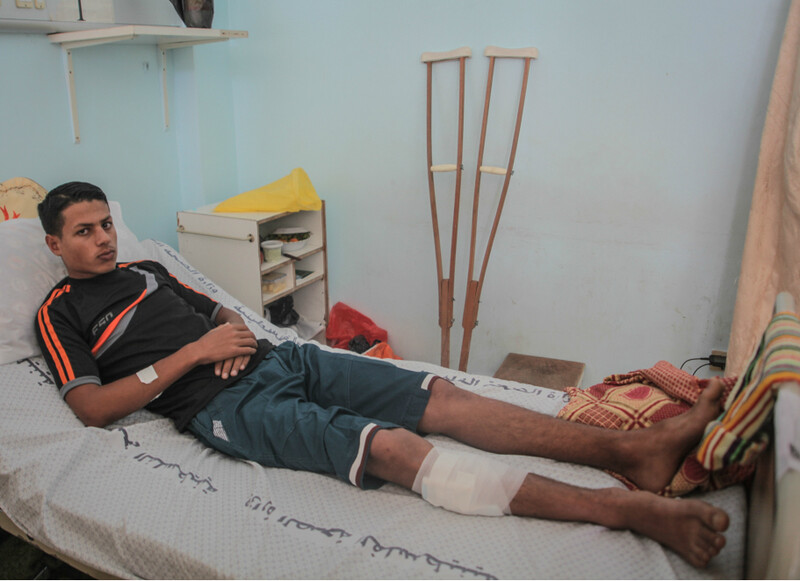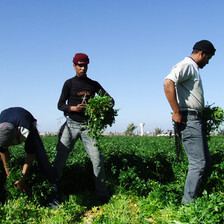The Electronic Intifada Gaza Strip 26 June 2015

Israeli soldiers shot 16-year-old Islam Samir Tawfiq Abu Reda in the leg.
On Monday, 22 June, Israeli soldiers fired on a group of four boys aged 16 to 17 in the southern Gaza Strip village of Khuzaa. Two of the boys were hit in the legs and one was critically injured.
The four friends had walked out to the edge of the village to spend the final hour of their fast for Ramadan.
“We were there to waste time before iftar [the meal that breaks the fast],” Muhammad Sami Abu Reda, 17, told The Electronic Intifada. Muhammad was one of the two boys who escaped injury on Monday.
“It’s a very nice area. You can see the fields and farms, and we go there because it used to be closed off but now they told us we can go there,” he explained.
Severe injuries
Last month, the Hamas-led government in Gaza announced the opening of a road that runs alongside the “buffer zone,” the no-go area imposed by Israel which covers a wide swath of land on the Gaza side of the boundary with Israel, in the east and north.
The “buffer zone” was supposed to be reduced in size under the terms of last August’s ceasefire between Hamas and Israel following Israel’s 51-day attack. However, it remains unclear just where Palestinians can safely walk, drive or farm.
In the month of May alone, Israeli soldiers fired on 14 people who were close to the boundary, leaving six Palestinians injured, according to the Palestinian Centre for Human Rights (PCHR).
Islam Samir Tawfiq Abu Reda, 16, is one of the boys shot on Monday. Lying on his hospital bed, he told The Electronic Intifada that “everyone went to the road since it was announced on the news that it had been opened.”
Islam’s calf was struck by a bullet. While his wound required more than a dozen stitches, he is healing well.
But the other youth, Ibrahim Abu Reda, remains in intensive care. The outcome of his far more severe injuries is uncertain. Two bullets entered his right leg, one near the ankle and another below the knee, shattering his shinbone and severing veins and arteries.
The night he was shot, Ibrahim was treated by Dr. Qasim Kamel in a six-hour surgery at the European Hospital near Rafah, a city in southern Gaza. Kamel told The Electronic Intifada he hopes that he will not need to amputate the teenager’s leg.
In Ibrahim’s home, his parents showed this reporter photographs of the boy lifting weights and playing sports. His father, Jamal Ahmad Abu Reda, said Ibrahim was in Khuzaa’s soccer club and loved to go to the gym. He struggled not to cry as he described his son.
With tears streaming down her face, Safaa Abu Reda, Ibrahim’s mother, said “It’s my right to see my son walking.”
She is desperately worried that her son will not be able to receive adequate treatment in Gaza and wants him to be transferred to Israel. Doctors have told her that the likelihood that Ibrahim will be able to walk again is a slim 15 percent. She believes the odds would be higher if he could get treatment in Israel.
“Why are they doing this to my son? He had no weapons,” she said. “He just went there to walk and have fun, like everyone.”
Ibrahim is the younger brother of Ahmed Abu Reda, 18, who was used as a human shield by Israeli soldiers for five days during last summer’s war, as documented by the recent UN Human Rights Council’s independent investigation of Israel’s assault on Gaza as well as by other independent observers.
Ahmed was detained by Israeli soldiers on 23 July while attempting to flee Khuzaa with the rest of his family during Israel’s 11-day ground invasion of the small village.
“Buffer zone”
Before one reaches Khuzaa’s boundary with Israel, one must drive through cultivated farmland and greenhouses where farmers grow tomatoes, melons, peppers and zucchini on plots of land demarcated with thickets of crawling cactus.
As one approaches Israel, an inconspicuous fence appears. An Israeli watchtower stands behind. This is the boundary.
Since 2005, Israel has guarded the so-called “buffer zone” here, preventing farmers from safely accessing their lands that lie within it.
While initially the zone stretched 150 meters wide into tiny Gaza, Israel has expanded it over time. In 2010 the buffer zone grew to a 300-meter-wide area that runs alongside the boundary wall.
While the area was supposed to be reduced to 100 meters following the ceasefire, Hamdi Shaqqura, deputy director of PCHR, told The Electronic Intifada that people are fired on as far away as 500 meters from the border. “There is no guarantee from Israel or the international community that Palestinians will have access to their land,” he said.
At the beginning of this year, Gisha, an Israeli organization that monitors Palestinians’ ability to move freely in and out of Gaza, sent an information request to the Israeli military regarding its policy toward the buffer zone following the ceasefire.
Like PCHR, their data also shows that the ban was enforced on a larger area than was officially declared. They have yet to receive a response from the military.
“Silent gunshots”
At the hospital, The Electronic Intifada met the two other boys who were with Ibrahim and Islam when they were shot. Muhammad Sami Abu Reda, 17, said there was no sign that any Israeli soldiers were around. The boys had just paused for a moment while taking their walk when Islam suddenly fell to the ground. Then Ibrahim. Muhammad said the gunshots were silent.
“There were no warning shots,” Muhammad explained.
Muhammad and the other youth, Hisham Abu Mutliq, 17, tried to pick their friends up off the ground, but more shots were fired toward them.
“We ran behind a sand hill to take cover, but the Israelis kept shooting,” Hisham said.
The boys were able to use their mobile phones to call an ambulance, but help did not arrive for 15 minutes. The injured boys lay bleeding on the ground.
Kamel is hopeful that Ibrahim’s leg will heal after the surgery. When The Electronic Intifada visited him at the hospital, Ibrahim was in a deep sleep, but Kamel said he has been lucid and talking in between resting.
There has been a partial clearing of the rubble in Khuzaa, restoring a semblance of normalcy. The ruins of many of the demolished homes, of which nearly 400 were completely destroyed, have been swept into neat mounds, though some remain standing with their roofs sunken through to the ground.
The least destroyed of homes still show walls riddled with bullet holes. The molding on the minaret of a mosque in the center of the village is nearly entirely blown off.
And while Israel’s war on Gaza was declared over, the residents of Khuzaa remain under fire.
Charlotte Silver is a journalist based in San Francisco. Twitter: @CharESilver





